Florida National University HSA-5114 Week 5: Manage Care Cost Plan
VerifiedAdded on 2022/10/01
|6
|1386
|22
Report
AI Summary
This report analyzes a managed care cost plan within the context of the US healthcare system, addressing the historical evolution from fee-for-service to managed care models. It explores the strategies employed by managed care organizations (MCOs) to control costs, including financing, delivery, and payment mechanisms, with a focus on premium negotiation, risk management, and the integration of various healthcare entities. The report highlights the importance of balancing cost-effectiveness with the quality of care, examining provider reimbursement, and the role of integrated systems like IDSs and ACOs in improving cost savings. Furthermore, it delves into long-term care services, emphasizing community-based and home-based care, and the need for patient-centered approaches, concluding with a discussion on the socioeconomic factors impacting healthcare costs and the significance of legislative and policy changes in shaping a sustainable healthcare system. The report emphasizes the need for a balanced approach to cost control and quality of care, with a focus on integrated systems and patient-centered services, and the importance of reimbursement models in designing integrated management frameworks.
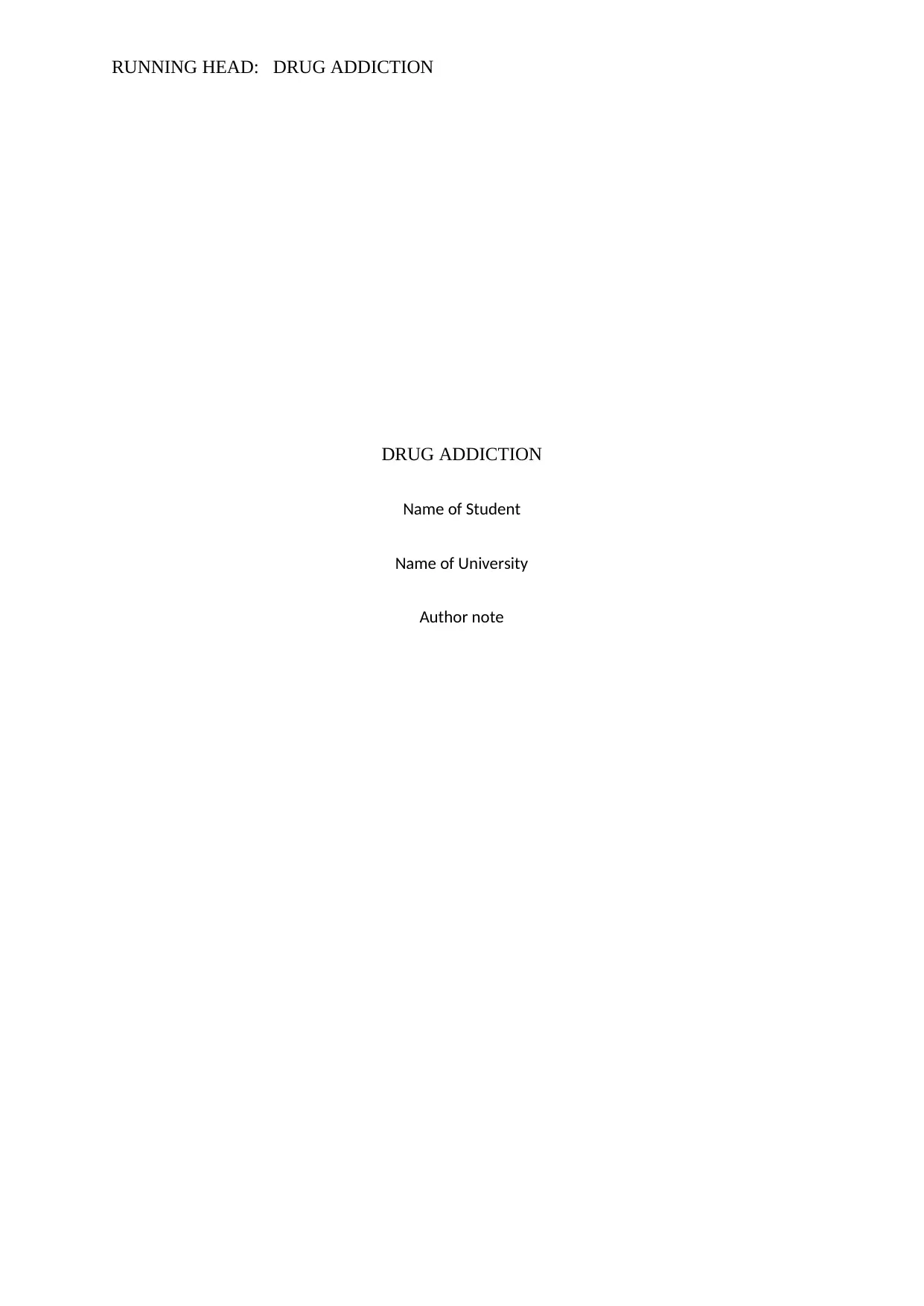
RUNNING HEAD: DRUG ADDICTION
DRUG ADDICTION
Name of Student
Name of University
Author note
DRUG ADDICTION
Name of Student
Name of University
Author note
Paraphrase This Document
Need a fresh take? Get an instant paraphrase of this document with our AI Paraphraser
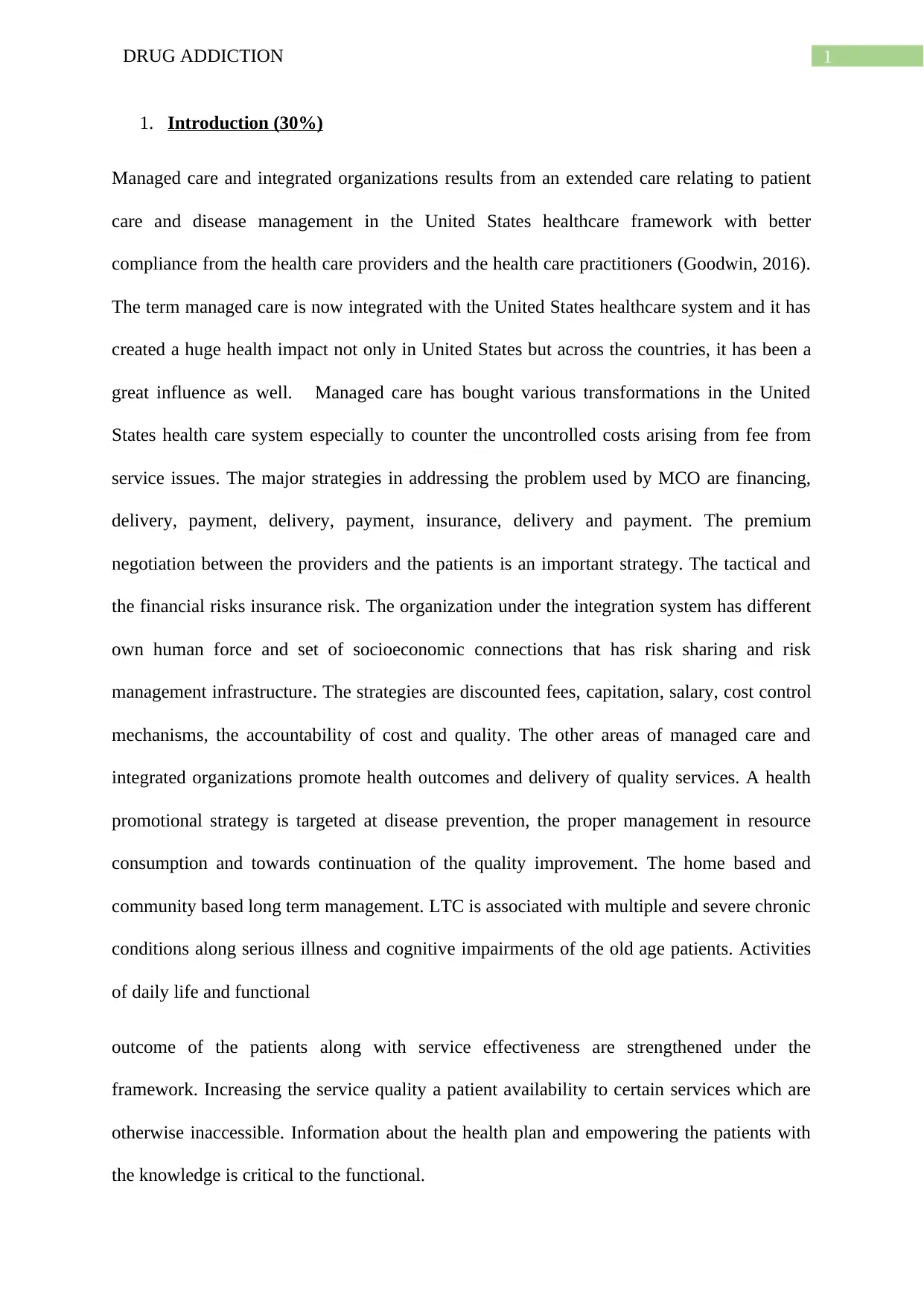
1DRUG ADDICTION
1. Introduction (30%)
Managed care and integrated organizations results from an extended care relating to patient
care and disease management in the United States healthcare framework with better
compliance from the health care providers and the health care practitioners (Goodwin, 2016).
The term managed care is now integrated with the United States healthcare system and it has
created a huge health impact not only in United States but across the countries, it has been a
great influence as well. Managed care has bought various transformations in the United
States health care system especially to counter the uncontrolled costs arising from fee from
service issues. The major strategies in addressing the problem used by MCO are financing,
delivery, payment, delivery, payment, insurance, delivery and payment. The premium
negotiation between the providers and the patients is an important strategy. The tactical and
the financial risks insurance risk. The organization under the integration system has different
own human force and set of socioeconomic connections that has risk sharing and risk
management infrastructure. The strategies are discounted fees, capitation, salary, cost control
mechanisms, the accountability of cost and quality. The other areas of managed care and
integrated organizations promote health outcomes and delivery of quality services. A health
promotional strategy is targeted at disease prevention, the proper management in resource
consumption and towards continuation of the quality improvement. The home based and
community based long term management. LTC is associated with multiple and severe chronic
conditions along serious illness and cognitive impairments of the old age patients. Activities
of daily life and functional
outcome of the patients along with service effectiveness are strengthened under the
framework. Increasing the service quality a patient availability to certain services which are
otherwise inaccessible. Information about the health plan and empowering the patients with
the knowledge is critical to the functional.
1. Introduction (30%)
Managed care and integrated organizations results from an extended care relating to patient
care and disease management in the United States healthcare framework with better
compliance from the health care providers and the health care practitioners (Goodwin, 2016).
The term managed care is now integrated with the United States healthcare system and it has
created a huge health impact not only in United States but across the countries, it has been a
great influence as well. Managed care has bought various transformations in the United
States health care system especially to counter the uncontrolled costs arising from fee from
service issues. The major strategies in addressing the problem used by MCO are financing,
delivery, payment, delivery, payment, insurance, delivery and payment. The premium
negotiation between the providers and the patients is an important strategy. The tactical and
the financial risks insurance risk. The organization under the integration system has different
own human force and set of socioeconomic connections that has risk sharing and risk
management infrastructure. The strategies are discounted fees, capitation, salary, cost control
mechanisms, the accountability of cost and quality. The other areas of managed care and
integrated organizations promote health outcomes and delivery of quality services. A health
promotional strategy is targeted at disease prevention, the proper management in resource
consumption and towards continuation of the quality improvement. The home based and
community based long term management. LTC is associated with multiple and severe chronic
conditions along serious illness and cognitive impairments of the old age patients. Activities
of daily life and functional
outcome of the patients along with service effectiveness are strengthened under the
framework. Increasing the service quality a patient availability to certain services which are
otherwise inaccessible. Information about the health plan and empowering the patients with
the knowledge is critical to the functional.
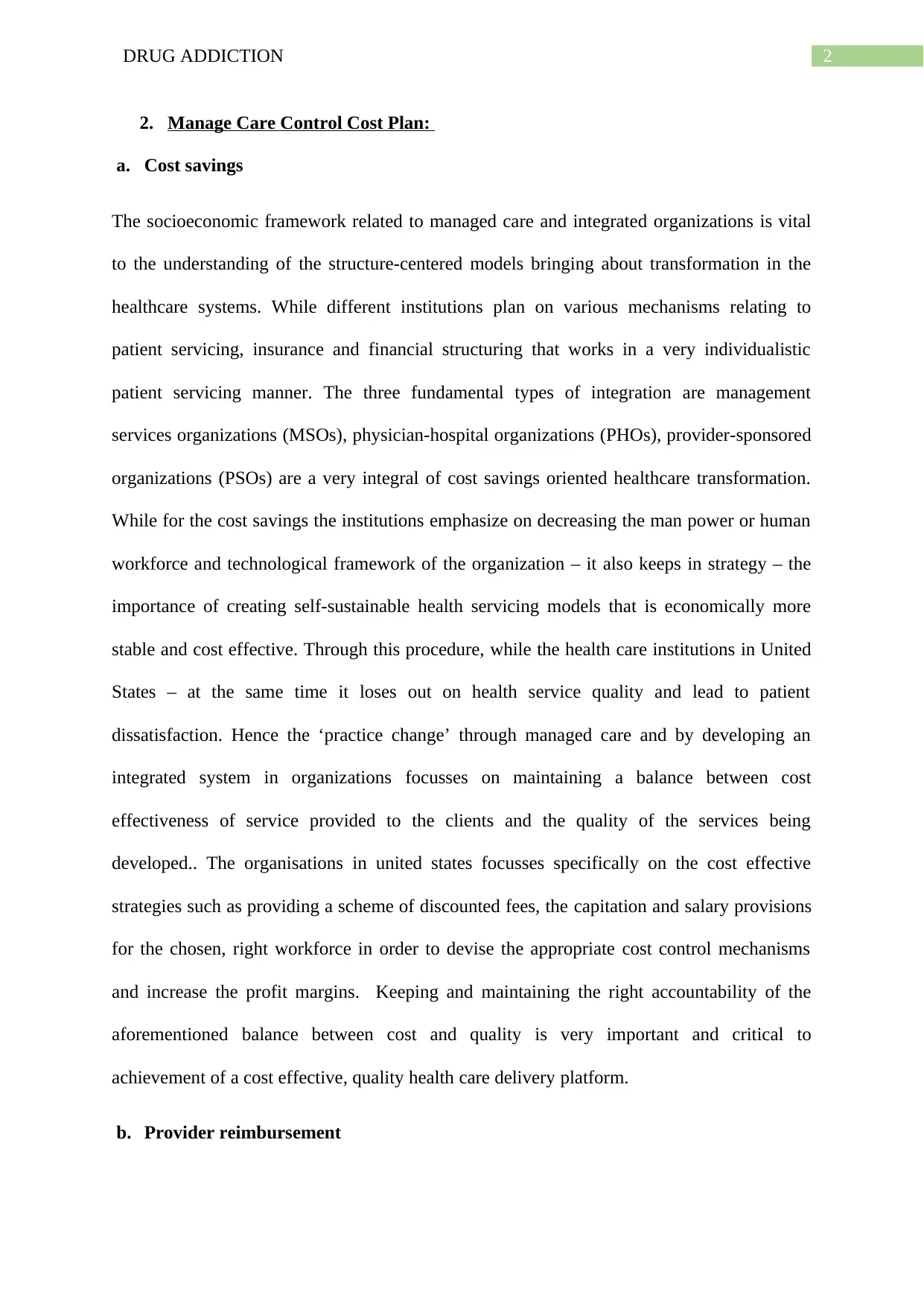
2DRUG ADDICTION
2. Manage Care Control Cost Plan:
a. Cost savings
The socioeconomic framework related to managed care and integrated organizations is vital
to the understanding of the structure-centered models bringing about transformation in the
healthcare systems. While different institutions plan on various mechanisms relating to
patient servicing, insurance and financial structuring that works in a very individualistic
patient servicing manner. The three fundamental types of integration are management
services organizations (MSOs), physician-hospital organizations (PHOs), provider-sponsored
organizations (PSOs) are a very integral of cost savings oriented healthcare transformation.
While for the cost savings the institutions emphasize on decreasing the man power or human
workforce and technological framework of the organization – it also keeps in strategy – the
importance of creating self-sustainable health servicing models that is economically more
stable and cost effective. Through this procedure, while the health care institutions in United
States – at the same time it loses out on health service quality and lead to patient
dissatisfaction. Hence the ‘practice change’ through managed care and by developing an
integrated system in organizations focusses on maintaining a balance between cost
effectiveness of service provided to the clients and the quality of the services being
developed.. The organisations in united states focusses specifically on the cost effective
strategies such as providing a scheme of discounted fees, the capitation and salary provisions
for the chosen, right workforce in order to devise the appropriate cost control mechanisms
and increase the profit margins. Keeping and maintaining the right accountability of the
aforementioned balance between cost and quality is very important and critical to
achievement of a cost effective, quality health care delivery platform.
b. Provider reimbursement
2. Manage Care Control Cost Plan:
a. Cost savings
The socioeconomic framework related to managed care and integrated organizations is vital
to the understanding of the structure-centered models bringing about transformation in the
healthcare systems. While different institutions plan on various mechanisms relating to
patient servicing, insurance and financial structuring that works in a very individualistic
patient servicing manner. The three fundamental types of integration are management
services organizations (MSOs), physician-hospital organizations (PHOs), provider-sponsored
organizations (PSOs) are a very integral of cost savings oriented healthcare transformation.
While for the cost savings the institutions emphasize on decreasing the man power or human
workforce and technological framework of the organization – it also keeps in strategy – the
importance of creating self-sustainable health servicing models that is economically more
stable and cost effective. Through this procedure, while the health care institutions in United
States – at the same time it loses out on health service quality and lead to patient
dissatisfaction. Hence the ‘practice change’ through managed care and by developing an
integrated system in organizations focusses on maintaining a balance between cost
effectiveness of service provided to the clients and the quality of the services being
developed.. The organisations in united states focusses specifically on the cost effective
strategies such as providing a scheme of discounted fees, the capitation and salary provisions
for the chosen, right workforce in order to devise the appropriate cost control mechanisms
and increase the profit margins. Keeping and maintaining the right accountability of the
aforementioned balance between cost and quality is very important and critical to
achievement of a cost effective, quality health care delivery platform.
b. Provider reimbursement
⊘ This is a preview!⊘
Do you want full access?
Subscribe today to unlock all pages.

Trusted by 1+ million students worldwide
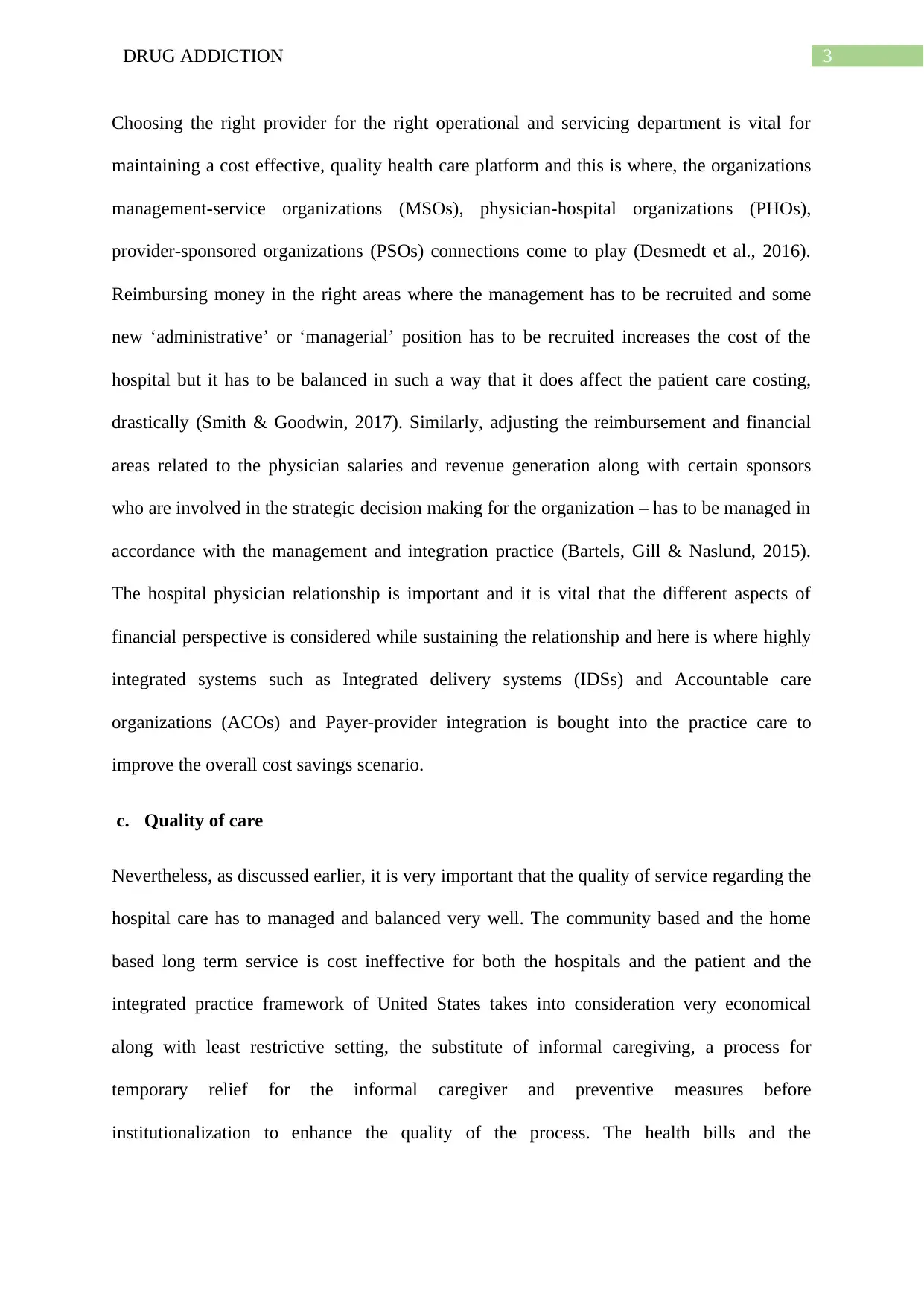
3DRUG ADDICTION
Choosing the right provider for the right operational and servicing department is vital for
maintaining a cost effective, quality health care platform and this is where, the organizations
management-service organizations (MSOs), physician-hospital organizations (PHOs),
provider-sponsored organizations (PSOs) connections come to play (Desmedt et al., 2016).
Reimbursing money in the right areas where the management has to be recruited and some
new ‘administrative’ or ‘managerial’ position has to be recruited increases the cost of the
hospital but it has to be balanced in such a way that it does affect the patient care costing,
drastically (Smith & Goodwin, 2017). Similarly, adjusting the reimbursement and financial
areas related to the physician salaries and revenue generation along with certain sponsors
who are involved in the strategic decision making for the organization – has to be managed in
accordance with the management and integration practice (Bartels, Gill & Naslund, 2015).
The hospital physician relationship is important and it is vital that the different aspects of
financial perspective is considered while sustaining the relationship and here is where highly
integrated systems such as Integrated delivery systems (IDSs) and Accountable care
organizations (ACOs) and Payer-provider integration is bought into the practice care to
improve the overall cost savings scenario.
c. Quality of care
Nevertheless, as discussed earlier, it is very important that the quality of service regarding the
hospital care has to managed and balanced very well. The community based and the home
based long term service is cost ineffective for both the hospitals and the patient and the
integrated practice framework of United States takes into consideration very economical
along with least restrictive setting, the substitute of informal caregiving, a process for
temporary relief for the informal caregiver and preventive measures before
institutionalization to enhance the quality of the process. The health bills and the
Choosing the right provider for the right operational and servicing department is vital for
maintaining a cost effective, quality health care platform and this is where, the organizations
management-service organizations (MSOs), physician-hospital organizations (PHOs),
provider-sponsored organizations (PSOs) connections come to play (Desmedt et al., 2016).
Reimbursing money in the right areas where the management has to be recruited and some
new ‘administrative’ or ‘managerial’ position has to be recruited increases the cost of the
hospital but it has to be balanced in such a way that it does affect the patient care costing,
drastically (Smith & Goodwin, 2017). Similarly, adjusting the reimbursement and financial
areas related to the physician salaries and revenue generation along with certain sponsors
who are involved in the strategic decision making for the organization – has to be managed in
accordance with the management and integration practice (Bartels, Gill & Naslund, 2015).
The hospital physician relationship is important and it is vital that the different aspects of
financial perspective is considered while sustaining the relationship and here is where highly
integrated systems such as Integrated delivery systems (IDSs) and Accountable care
organizations (ACOs) and Payer-provider integration is bought into the practice care to
improve the overall cost savings scenario.
c. Quality of care
Nevertheless, as discussed earlier, it is very important that the quality of service regarding the
hospital care has to managed and balanced very well. The community based and the home
based long term service is cost ineffective for both the hospitals and the patient and the
integrated practice framework of United States takes into consideration very economical
along with least restrictive setting, the substitute of informal caregiving, a process for
temporary relief for the informal caregiver and preventive measures before
institutionalization to enhance the quality of the process. The health bills and the
Paraphrase This Document
Need a fresh take? Get an instant paraphrase of this document with our AI Paraphraser
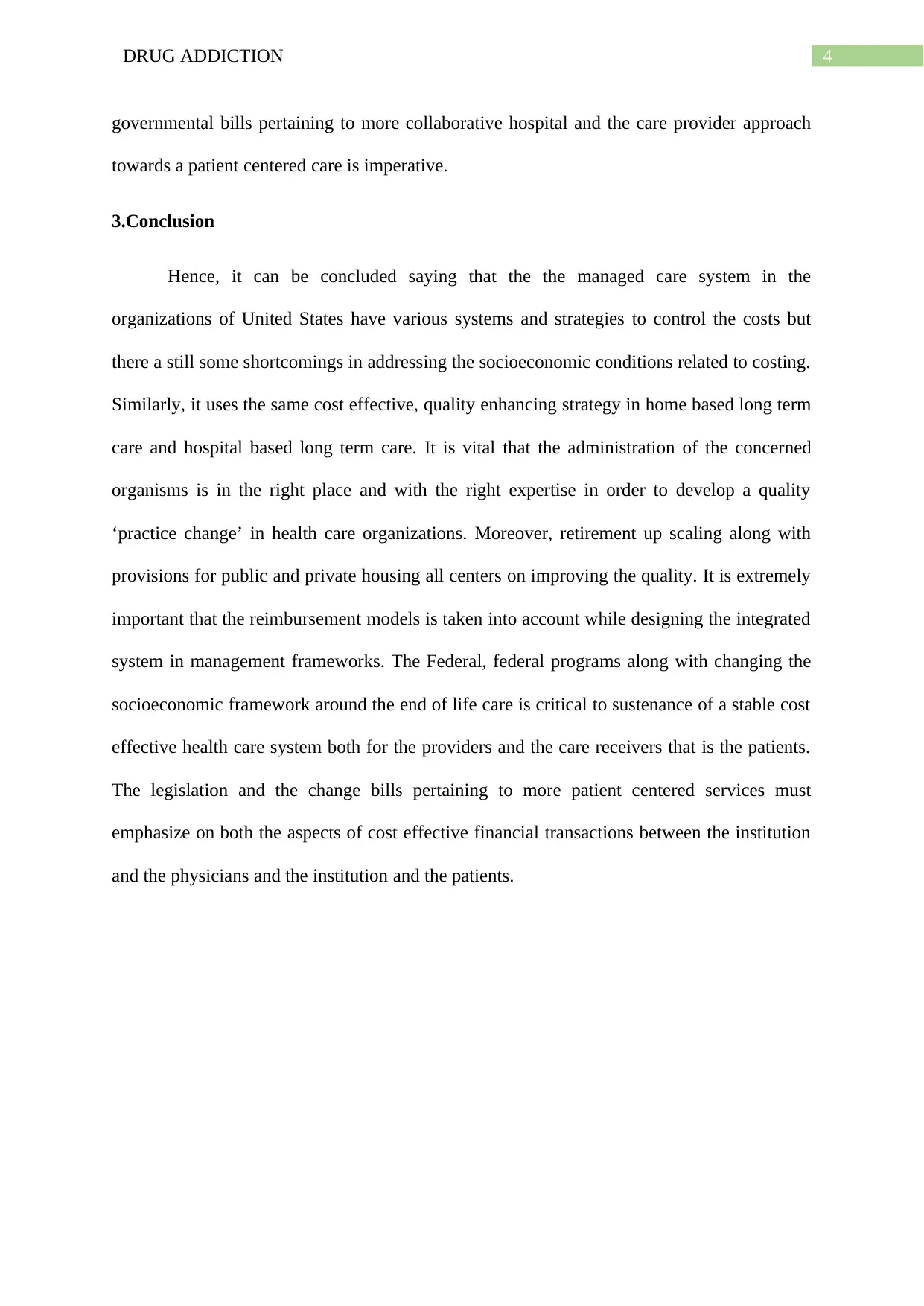
4DRUG ADDICTION
governmental bills pertaining to more collaborative hospital and the care provider approach
towards a patient centered care is imperative.
3.Conclusion
Hence, it can be concluded saying that the the managed care system in the
organizations of United States have various systems and strategies to control the costs but
there a still some shortcomings in addressing the socioeconomic conditions related to costing.
Similarly, it uses the same cost effective, quality enhancing strategy in home based long term
care and hospital based long term care. It is vital that the administration of the concerned
organisms is in the right place and with the right expertise in order to develop a quality
‘practice change’ in health care organizations. Moreover, retirement up scaling along with
provisions for public and private housing all centers on improving the quality. It is extremely
important that the reimbursement models is taken into account while designing the integrated
system in management frameworks. The Federal, federal programs along with changing the
socioeconomic framework around the end of life care is critical to sustenance of a stable cost
effective health care system both for the providers and the care receivers that is the patients.
The legislation and the change bills pertaining to more patient centered services must
emphasize on both the aspects of cost effective financial transactions between the institution
and the physicians and the institution and the patients.
governmental bills pertaining to more collaborative hospital and the care provider approach
towards a patient centered care is imperative.
3.Conclusion
Hence, it can be concluded saying that the the managed care system in the
organizations of United States have various systems and strategies to control the costs but
there a still some shortcomings in addressing the socioeconomic conditions related to costing.
Similarly, it uses the same cost effective, quality enhancing strategy in home based long term
care and hospital based long term care. It is vital that the administration of the concerned
organisms is in the right place and with the right expertise in order to develop a quality
‘practice change’ in health care organizations. Moreover, retirement up scaling along with
provisions for public and private housing all centers on improving the quality. It is extremely
important that the reimbursement models is taken into account while designing the integrated
system in management frameworks. The Federal, federal programs along with changing the
socioeconomic framework around the end of life care is critical to sustenance of a stable cost
effective health care system both for the providers and the care receivers that is the patients.
The legislation and the change bills pertaining to more patient centered services must
emphasize on both the aspects of cost effective financial transactions between the institution
and the physicians and the institution and the patients.
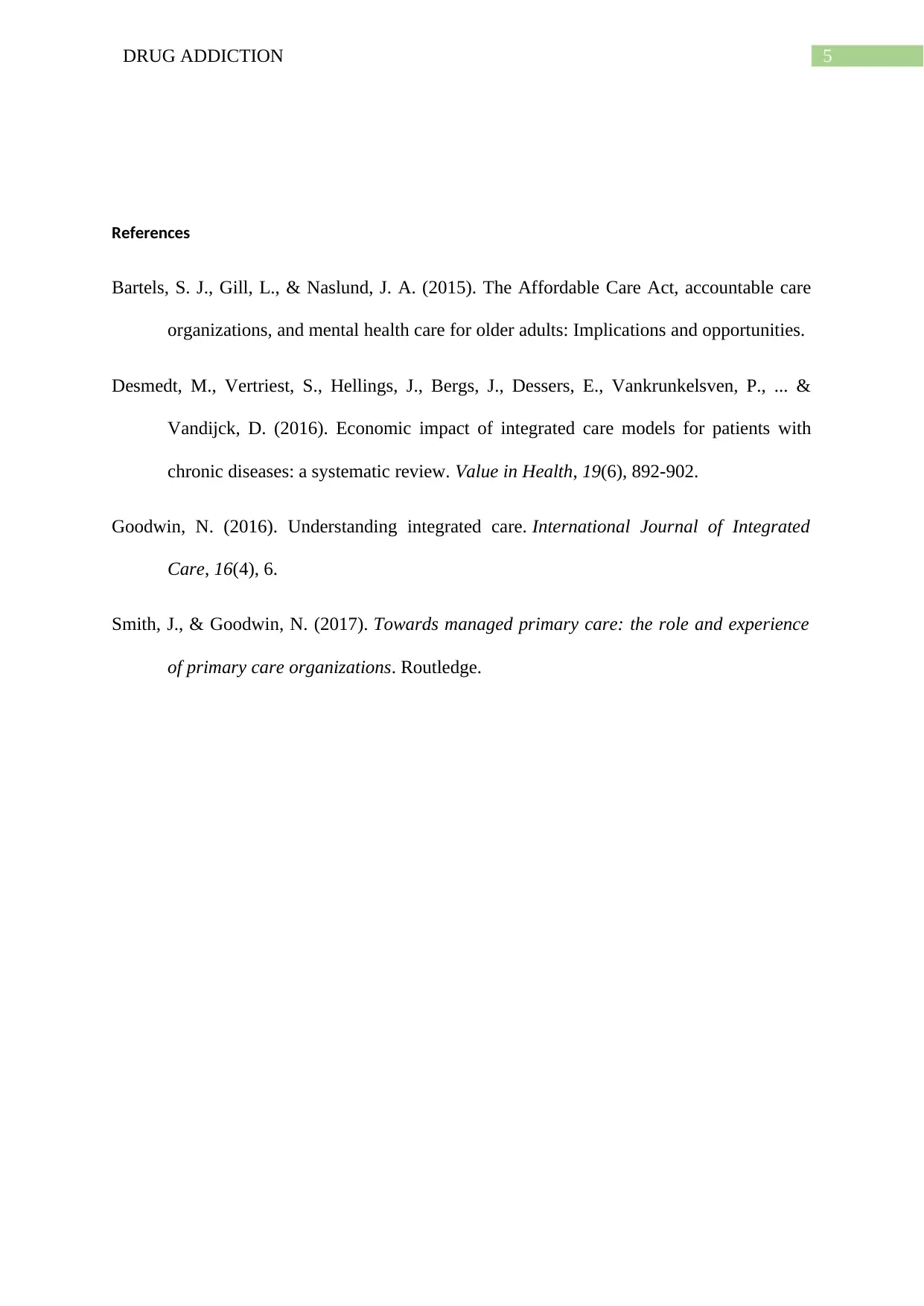
5DRUG ADDICTION
References
Bartels, S. J., Gill, L., & Naslund, J. A. (2015). The Affordable Care Act, accountable care
organizations, and mental health care for older adults: Implications and opportunities.
Desmedt, M., Vertriest, S., Hellings, J., Bergs, J., Dessers, E., Vankrunkelsven, P., ... &
Vandijck, D. (2016). Economic impact of integrated care models for patients with
chronic diseases: a systematic review. Value in Health, 19(6), 892-902.
Goodwin, N. (2016). Understanding integrated care. International Journal of Integrated
Care, 16(4), 6.
Smith, J., & Goodwin, N. (2017). Towards managed primary care: the role and experience
of primary care organizations. Routledge.
References
Bartels, S. J., Gill, L., & Naslund, J. A. (2015). The Affordable Care Act, accountable care
organizations, and mental health care for older adults: Implications and opportunities.
Desmedt, M., Vertriest, S., Hellings, J., Bergs, J., Dessers, E., Vankrunkelsven, P., ... &
Vandijck, D. (2016). Economic impact of integrated care models for patients with
chronic diseases: a systematic review. Value in Health, 19(6), 892-902.
Goodwin, N. (2016). Understanding integrated care. International Journal of Integrated
Care, 16(4), 6.
Smith, J., & Goodwin, N. (2017). Towards managed primary care: the role and experience
of primary care organizations. Routledge.
⊘ This is a preview!⊘
Do you want full access?
Subscribe today to unlock all pages.

Trusted by 1+ million students worldwide
1 out of 6
Related Documents
Your All-in-One AI-Powered Toolkit for Academic Success.
+13062052269
info@desklib.com
Available 24*7 on WhatsApp / Email
![[object Object]](/_next/static/media/star-bottom.7253800d.svg)
Unlock your academic potential
Copyright © 2020–2025 A2Z Services. All Rights Reserved. Developed and managed by ZUCOL.





